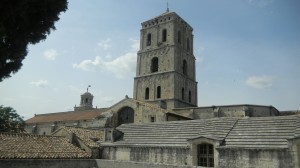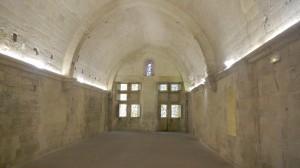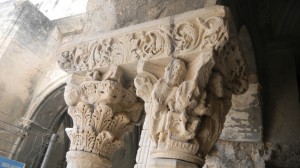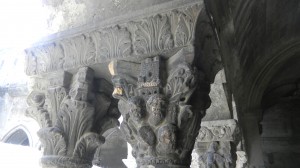What could be more perfect than Romanesque style’s simple geometrical order?
The Romanesque arches rising towards the heavens at Saint Trophime in Arles, France (above) gave the people living in its cloister a unified world under God. But this unity that church authorities tried to impose was too perfect. If you examine many Romanesque buildings deeply enough, you’ll find features that those arches couldn’t encompass.
Capitals over the columns in many Romanesque buildings are surprisingly lively. Animals, monsters and animated foliage surround human figures in a jumble of forms and creatures that contradicts the simple unity that the arches try to hold. What gives?
The cloister’s interior at Saint Trophime (above) looks innocent enough. Monks slept and ate in long rooms like this. But–
Look at the animated forms of the capitals over the columns in the courtyard. In general, the capitals in German Romanesque cathedrals are more restrained, but French builders sometimes seem to have rebelled against the simplicity of the arches. Of course showing the diversity of all life expressed the unified world God created. But–
These explosion of life forms at Saint Trophime and many other monasteries and churches seemed like overdoing it to some. Saint Bernard, that master of buzz-kill that you can meet in an earlier post, thought so. But we can note two things:
1. Medieval people believed that God created all creatures, including beasts and demons, and all had to be included in order to express God’s unity.
2. Europe in the 11th and early 12th century wasn’t as literate as it became in the 13th. And fewer people lived in cities. Most Medieval folks believed in magical powers in nature, and they didn’t yet have the more realistic sculpture and painting that developed in the 13th century to give more logical forms to God’s unity. The animated forms of these capitals probably appealed to feelings and folk beliefs that would have found the strict order in Speyer Cathedral cold.
But many Romanesque capitals in France are so exuberant that the simple geometric forms that try to surround them seem about to burst. Romanesque architecture reveals a dilemma. Most people want a unified world, but try to unify it too tightly and folks will rebel and look for more meanings.
The society that Romanesque art emerged in was facing this dilemma in general. The emerging new forms of literacy, sculpture and painting in the 12th century would flower into Gothic style, which would have these new languages to express both the material and spiritual world with even more variety and vividness. Europeans were looking for new meanings as their society became more literate and urban, and the Church had these new artistic media and languages to express and try to unify them. The tension between both would create some of the greatest art in Western history.





Comments on this entry are closed.